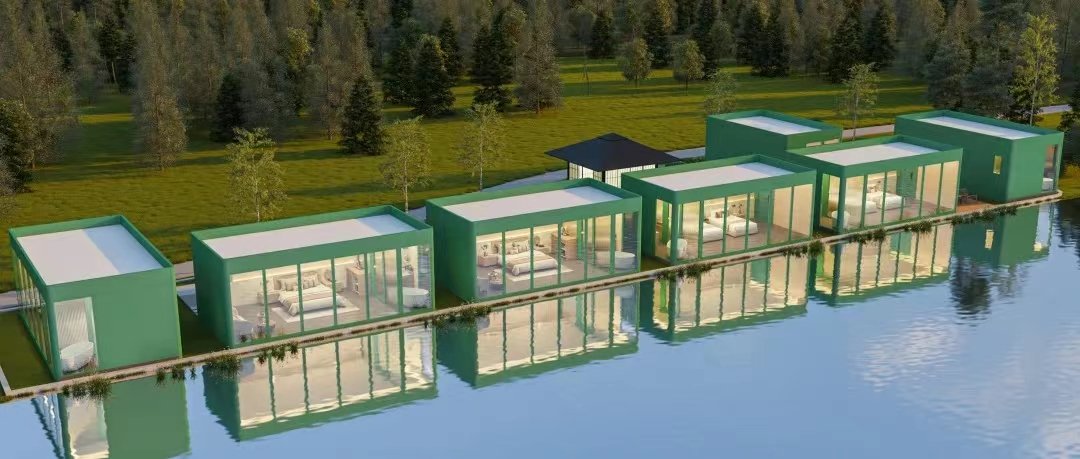
Think about walking through a big steel container and calling it home. Most people scoff at the idea of creating a home out of shipping containers and imagine small, rusty, and difficult-to-deal-with spaces. However, by knowing how to do it right, you can transform steel box homes into beautiful, efficient places to live. Not only that, they’re also budget-friendly and great for the environment. The key? Knowing how to build them right. This guide will walk you through every step of creating your own container house, from laying the groundwork and planning all the way to the finishing touches.
A Simple Approach to Creating Your Container Home Building your own container home is the best of design, sustainability, and affordability all wrapped up into one exciting project. At CubiNest, we build modular container homes and have extensive experience helping customers from all over the world build their dream homes. From a simple container cabin to massive multi-container residences, we have seen it all. This guide will give you the confidence and understanding you need to turn raw shipping containers into the home of your dreams.
How to Build a Shipping Container House
Creating a shipping container house requires careful planning, premium materials, and some technical skills. Here is an overview of the key steps involved in building your own container home.
Step 1: Do Your Home Work
Before you start go through the following checklist of everything you need to consider before you begin:
- Local Regulations: Look into zoning laws, building permits, and safety codes in your area. You must ensure your container home is fully compliant with these regulations to avoid legal hassles down the line.
- Choose Your Containers: Inspect the containers you wish to use. Check for structural integrity and rust issues—your containers need to be in good condition for a solid home.
- Design the Layout: Plan the layout, number of containers, and how they will be configured. Consider whether you want a single or multi-level home, and sketch a preliminary design that fits your vision.
Step 2: Site Preparation
Getting the site ready is the first step to making a stable base for your home:
- Choose a Rock-Solid Spot: Choose a stable site that provides good drainage. Avoid low-lying areas that are prone to flooding.
- Clean the Ground: Remove any vegetation or debris. Use a shovel, rake, and tamper to level the ground, preparing it for foundation work.
Step 3: Lay a Beefy Base
The foundation is the most important part of your container home:
- Concrete Slab: This is the most common type, suitable for flat areas. It provides a solid base to support the weight of the container.
- Pier Foundation: Concrete piers are set at strategic points under each container corner, which allows for airflow and prevents moisture build-up under the home.
- Strip Foundation: Concrete strips along the container edges are ideal for lighter structures.
Follow these steps for laying a foundation:
- Mark the Layout: Mark the exact dimensions of the foundation to ensure accuracy.
- Excavate: Dig holes or trenches based on your chosen foundation type.
- Pour Concrete: Pour the concrete and allow it to set before proceeding to container placement.
Step 4: Installing Containers
Once the foundation is complete:
- Position Containers: Use a crane to move the shipping containers into position on the foundation. Make sure they are correctly aligned.
- Secure Containers: Use bolts or weld the containers to the foundation, securing them in place for safety and stability.
Step 5: Connecting Containers
For larger homes that use multiple containers:
- Weld Containers Together: Welding the sides of the containers ensures a secure connection between them.
- Sealing Gaps: Use weatherproof sealants to prevent air leaks and protect against the elements.
Step 6: Roofing
Installing a proper roof is important for both insulation and weather protection:
- Choose Roofing Materials: You can opt for traditional materials like asphalt shingles or metal roofing panels for added durability.
- Design for Rainwater Harvesting: Installing a slight slope and gutters allows for efficient rainwater collection, promoting sustainable water usage.
Step 7: Interior Finishing
This is where you make the container livable:
- Insulation: Proper insulation is key to making the space comfortable. Use spray foam, rigid foam, or fiberglass insulation.
- Electrical and Plumbing: Run electrical wiring and plumbing according to your design. Make sure all work complies with local building codes.
- Interior Design: Once the technical installations are complete, focus on interior design—paint the walls, lay flooring, and install fixtures and fittings to personalize the space.
Additional Considerations
- Create a Dirty Thumbs-up Slush Fund: Set aside 20% of your maximum budget for unexpected expenses.
- Buy Quality Stuff: Don’t go all woolly mammoth on something like this, but buy good materials to ensure that everything is properly and safely constructed.
- Add Green Options: Solar panels, green roofs, or low-energy windows are green ideas that will make your home as eco-friendly as it can be.
Building a container home can be incredibly rewarding if approached with the right mindset, tools, and strategies. By following these steps, you can create a space that reflects your personal taste and serves as a comfortable living environment.
Let’s Dive Deeper: Practical Tips for Building Your Container Home
People who create a shipping container house need to approach it with the right mindset, tools, and attitudes. By doing so, you can end up with a space that shows off your personality and serves as a comfortable home.
A Deeper Look: Tips You Can Use with Your Container Home Building a container home might sound complicated, but when it’s broken down step-by-step, it’s not that big of a deal. Let’s get more detailed now that you know the steps. Here, we will dive into various subjects, including which materials are best for foundations, how to level containers, what common modifications people make, the best ways to insulate them, and what you should be thinking about when running wiring for electricity.
What Do I Use to Make the Foundation of My Container Home?
The foundation of your container home is going to depend based on where you live and how much money you have to spend:
- Concrete: Concrete slabs are the standard choice due to their strength and reliability. They work really well if the land is solid and flat.
- Steel Piers: Steel beams give you the option to have a foundation when you can’t pour concrete. Plus, they are popular because they provide a strong base for the house and they allow air to get underneath as well.
- Sleepers: If money is an issue, you can use railroad ties. They are the cheapest way to make a foundation for your home. However, keep in mind that this kind of foundation might not be strong enough for a large house.
How Can I Make Sure My Containers are Square and Sturdy when I Put Them Down?
Making sure that your containers are perfectly square is as important as anything else you do when creating your new home:
- Use a Laser Level: A laser level provides precise measurements, ensuring that the ground or foundation is even.
- Watch When You Set Them: When using a crane, double-check the alignment of each container during placement. Adjustments are much easier to make before securing the container.
- Fasten Tightly: Use welding to attach containers to each other and bolts to secure them to the foundation. This prevents movement and adds stability.
How Do You Make a Storage Container Livable?
To make a shipping container home habitable, three things must be done:
- Cutting Out: Opening up the boxes for doors and windows is a must. You will need to restructure the steel by placing steel beams so the walls remain the same strength.
- Insulation: Steel containers can get hot or cold fast. Without insulation, the inside can get unbearable.
- Airflow: You have to put vents and windows in so the box can breathe. If you don’t do that, the condensation will ruin those steel boxes with rust.
What’s the Best Way to Insulate My Shipping Container?
The most vital part of making your shipping container home comfortable is the insulation you choose:
- Good Foam: This is the best way to fill things up and cut airflow.
- Rigid Boards: Rigid board is pretty cheap and makes that magic R-value number really high. With that, you will have a nice insulation for your container home.
- Fiberglass: Fiberglass works great and is cost effective. Just make sure the stuff doesn’t get wet. If it does, you’re looking at a real mess.
How Do You Handle Electrical Wiring in a Shipping Container House?
The electrical for a storage container house needs to be taken just as seriously:
Make sure your electrical work is done in accordance with local codes so you do everything safely.
- Comply with Local Codes: Electrical systems must meet local building codes to ensure safety.
- Install Conduits: Electrical wiring should be run through conduits to prevent damage and increase safety. Steel containers can easily conduct electricity, so ensuring that all wiring is properly shielded is a priority.
- Energy Efficiency: Consider using LED lighting and energy-efficient appliances to reduce electricity consumption.
You’re in Control
Building your own shipping container house isn’t really all that hard. By following the steps outlined here—with research and planning, site prep, creating your foundation, setting your shipping containers, and getting the inside buttoned up—you can have a house that’s amazing and stylish you can be proud of. Don’t skip the simple rules on foundation types, expert assembly, insulation, and electrical safety to do the job right and make it last for decades to come. Customizing your shipping container home can be kind of fun. Just remember, they’re not just inexpensive and eco-friendly. If you do it right, you can make them fit your style and taste. You know what? You can do this… and we’re here to help. Let’s build your dream home out of a shipping container!




